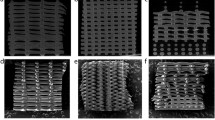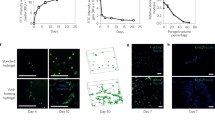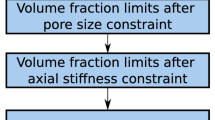Abstract
Porous architecture has a dramatic effect on tissue formation in porous biomaterials used in regenerative medicine. However, the wide variety of 3D structures used indicates there is a clear need for the optimal design of pore architecture to maximize tissue formation and ingrowth. Thus, the aim of this study was to characterize initial tissue growth solely as a function of pore geometry. We used an in vitro system with well-defined open pore slots of varying width, providing a 3D environment for neo-tissue formation while minimizing nutrient limitations. Results demonstrated that initial tissue formation was strongly influenced by pore geometry. Both velocity of tissue invasion and area of tissue formed increased as pores became narrower. This is associated with distinct patterns of actin organisation and alignment depending on pore width, indicating the role of active cell generated forces. A mathematical model based on curvature driven growth successfully predicted both shape of invasion front and constant rate of growth, which increased for narrower pores as seen in experiments. Our results provide further evidence for a front based, curvature driven growth mechanism depending on pore geometry and tissue organisation, which could provide important clues for 3D scaffold design.







Similar content being viewed by others
References
Andriotis, O., O. Katsamenis, D. Mouzakis, and N. Bouropoulos. Preparation and characterization of bioceramics produced from calcium phosphate cements. Cryst. Res. Technol. 45:239–243, 2010.
Aratyn-Schaus, Y., P. W. Oakes, and M. L. Gardel. Dynamic and structural signatures of lamellar actomyosin force generation. Mol. Biol. Cell 22:1330–1339, 2010.
Balaban, N. Q., U. S. Schwarz, D. Riveline, P. Goichberg, G. Tzur, I. Sabanay, D. Mahalu, S. Safran, A. Bershadsky, L. Addadi, and B. Geiger. Force and focal adhesion assembly: a close relationship studied using elastic micropatterned substrates. Nat. Cell Biol. 3:466–472, 2001.
Bidan C. M., K. P. Kommareddy, M. Rumpler, P. Kollmannsberger, Y. J. M. Bréchet, P. Fratzl, and J. W. C. Dunlop. How linear tension converts to curvature: geometric control of bone tissue growth. PLoS ONE 7(5): e36336, 2012. doi:10.1371/journal.pone.0036336.
Biton, Y. Y., and S. A. Safran. The cellular response to curvature-induced stress. Phys. Biol. 6:046010, 2009.
Blankenship, J. T., S. T. Backovic, J. S. Sanny, O. Weitz, and J. A. Zallen. Multicellular rosette formation links planar cell polarity to tissue morphogenesis. Dev. Cell 11:459–470, 2006.
Bohner, M., Y. Loosli, G. Baroud, and D. Lacroix. Commentary: deciphering the link between architecture and biological response of a bone graft substitute. Acta Biomater. 7:478–484, 2011.
Bowers, K. T., J. C. Keller, B. A. Randolph, D. G. Wick, and C. M. Michaels. Optimization of surface micromorphology for enhanced osteoblast responses in vitro. Int. J. Oral Maxillofac. Implants 7:302–310, 1992.
Buxboim, A., I. L. Ivanovska, and D. E. Discher. Matrix elasticity, cytoskeletal forces and physics of the nucleus: how deeply do cells ‘feel’ outside and in? J. Cell Sci. 123:297–308, 2010.
Dalby, M. J., N. Gadegaard, R. Tare, A. Andar, M. O. Riehle, P. Herzyk, C. D. Wilkinson, and R. O. Oreffo. The control of human mesenchymal cell differentiation using nanoscale symmetry and disorder. Nat. Mater. 6:997–1003, 2007.
Dawson, J. I., and R. O. C. Oreffo. Bridging the regeneration gap: stem cells, biomaterials and clinical translation in bone tissue engineering. Arch. Biochem. Biophys. 473:124–131, 2008.
Deligianni, D., N. Katsala, S. Ladas, D. Sotiropoulou, J. Amedee, and Y. Missirlis. Effect of surface roughness of the titanium alloy Ti–6Al–4V on human bone marrow cell response and on protein adsorption. Biomaterials 22:1241–1251, 2001.
Deshpande, V. S., R. M. McMeeking, and A. G. Evans. A model for the contractility of the cytoskeleton including the effects of stress-fibre formation and dissociation. Proc. R. Soc. A. Math. Phys. Eng. Sci. 463:787–815, 2007.
Ducheyne, P., and Q. Qiu. Bioactive ceramics: the effect of surface reactivity on bone formation and bone cell function. Biomaterials 20:2287–2303, 1999.
Elaine, N., and K. H. Marieb. Human Anatomy & Physiology. San Francisco, CA: Pearson Benjamin Cummings, 2010.
Engelmayr, Jr., G. C., G. D. Papworth, S. C. Watkins, J. E. Mayer, Jr., and M. S. Sacks. Guidance of engineered tissue collagen orientation by large-scale scaffold microstructures. J. Biomech. 39:1819–1831, 2006.
Frosch, K. H., F. Barvencik, C. H. Lohmann, V. Viereck, H. Siggelkow, J. Breme, K. Dresing, and K. M. Sturmer. Migration, matrix production and lamellar bone formation of human osteoblast-like cells in porous titanium implants. Cells Tissues Organs. 170:214–227, 2002.
Frosch, K. H., F. Barvencik, V. Viereck, C. H. Lohmann, K. Dresing, J. Breme, E. Brunner, and K. M. Sturmer. Growth behavior, matrix production, and gene expression of human osteoblasts in defined cylindrical titanium channels. J. Biomed. Mater. Res. A. 68:325–334, 2004.
Galbraith, C. G., and M. P. Sheetz. A micromachined device provides a new bend on fibroblast traction forces. Proc. Natl. Acad. Sci. USA 94:9114–9118, 1997.
Han, S. J., and N. J. Sniadecki. Simulations of the contractile cycle in cell migration using a bio-chemical-mechanical model. Comput. Methods Biomech. Biomed. Eng. 14:459–468, 2011.
Hollister, S. J., R. D. Maddox, and J. M. Taboas. Optimal design and fabrication of scaffolds to mimic tissue properties and satisfy biological constraints. Biomaterials 23:4095–4103, 2002.
Hulbert, S. F., F. A. Young, R. S. Mathews, J. J. Klawitter, C. D. Talbert, and F. H. Stelling. Potential of ceramic materials as permanently implantable skeletal prostheses. J. Biomed. Mater. Res. 4:433–456, 1970.
Kapfer, S. C., S. T. Hyde, K. Mecke, C. H. Arns, and G. E. Schroder-Turk. Minimal surface scaffold designs for tissue engineering. Biomaterials 32:6875–6882, 2011.
Karageorgiou, V., and D. Kaplan. Porosity of 3D biomaterial scaffolds and osteogenesis. Biomaterials 26:5474–5491, 2005.
Kong, H. J., T. R. Polte, E. Alsberg, and D. J. Mooney. FRET measurements of cell-traction forces and nano-scale clustering of adhesion ligands varied by substrate stiffness. Proc. Natl. Acad. Sci. U S A 102:4300–4305, 2005.
Lamolle, S. F., M. Monjo, M. Rubert, H. J. Haugen, S. P. Lyngstadaas, and J. E. Ellingsen. The effect of hydrofluoric acid treatment of titanium surface on nanostructural and chemical changes and the growth of MC3T3-E1 cells. Biomaterials 30:736–742, 2009.
Li, B., F. Li, K. M. Puskar, and J. H. Wang. Spatial patterning of cell proliferation and differentiation depends on mechanical stress magnitude. J. Biomech. 42:1622–1627, 2009.
Lincks, J., B. D. Boyan, C. R. Blanchard, C. H. Lohmann, Y. Liu, D. L. Cochran, D. D. Dean, and Z. Schwartz. Response of MG63 osteoblast-like cells to titanium and titanium alloy is dependent on surface roughness and composition. Biomaterials 19:2219–2232, 1998.
Lohmann, C. H., L. F. Bonewald, M. A. Sisk, V. L. Sylvia, D. L. Cochran, D. D. Dean, B. D. Boyan, and Z. Schwartz. Maturation state determines the response of osteogenic cells to surface roughness and 1,25-dihydroxyvitamin D3. J. Bone Miner. Res. 15:1169–1180, 2000.
Lossdörfer, S., Z. Schwartz, L. Wang, C. Lohmann, J. Turner, M. Wieland, D. Cochran, and B. Boyan. Microrough implant surface topographies increase osteogenesis by reducing osteoclast formation and activity. J. Biomed. Mater. Res., Part A 70:361–369, 2004.
Lu, J., B. Flautre, K. Anselme, P. Hardouin, A. Gallur, M. Descamps, and B. Thierry. Role of interconnections in porous bioceramics on bone recolonization in vitro and in vivo. J. Mater. Sci. Mater. Med. 10:111–120, 1999.
Mathur, A., S. W. Moore, M. P. Sheetz, and J. Hone. The role of feature curvature in contact guidance. Acta Biomater. 8:2595–2601, 2012.
Mege, R. M., J. Gavard, and M. Lambert. Regulation of cell–cell junctions by the cytoskeleton. Curr. Opin. Cell Biol. 18:541–548, 2006.
Melchels, F. P. W., A. Barradas, C. A. Van Blitterswijk, J. De Boer, J. Feijen, and D. W. Grijpma. Effects of the architecture of tissue engineering scaffolds on cell seeding and culturing. Acta Biomater. 6:4208–4217, 2010.
Montell, D. J. Morphogenetic cell movements: diversity from modular mechanical properties. Science 322:1502–1505, 2008.
Moroni, L., J. R. de Wijn, and C. A. van Blitterswijk. 3D fiber-deposited scaffolds for tissue engineering: influence of pores geometry and architecture on dynamic mechanical properties. Biomaterials 27:974–985, 2006.
Murray, J. D. Spatial models and biomedical applications. Math. Biol. 18:468–490, 2003.
Nathan, A. S., B. M. Baker, N. L. Nerurkar, and R. L. Mauck. Mechano-topographic modulation of stem cell nuclear shape on nanofibrous scaffolds. Acta Biomater. 7:57–66, 2011.
Nelson, C. M. Geometric control of tissue morphogenesis. Biochim. Biophys. Acta 1793:903–910, 2009.
Nelson, C. M., R. P. Jean, J. L. Tan, W. F. Liu, N. J. Sniadecki, A. A. Spector, and C. S. Chen. Emergent patterns of growth controlled by multicellular form and mechanics. Proc. Natl. Acad. Sci. U S A 102:11594–11599, 2005.
Pamula, E., L. Bacakova, E. Filova, J. Buczynska, P. Dobrzynski, L. Noskova, and L. Grausova. The influence of pore size on colonization of poly(L-lactide-glycolide) scaffolds with human osteoblast-like MG 63 cells in vitro. J. Mater. Sci. Mater. Med. 19:425–435, 2008.
Peyton, S. R., C. M. Ghajar, C. B. Khatiwala, and A. J. Putnam. The emergence of ECM mechanics and cytoskeletal tension as important regulators of cell function. Cell Biochem. Biophys. 47:300–320, 2007.
Ruiz, S. A., and C. S. Chen. Emergence of patterned stem cell differentiation within multicellular structures. Stem Cells 26:2921–2927, 2008.
Rumpler, M., A. Woesz, J. W. Dunlop, J. T. van Dongen, and P. Fratzl. The effect of geometry on three-dimensional tissue growth. J. R. Soc. Interface 5:1173–1180, 2008.
Sabetrasekh, R., H. Tiainen, J. Reseland, J. Will, J. Ellingsen, S. Lyngstadaas, and H. Haugen. Impact of trace elements on biocompatibility of titanium scaffolds. Biomed. Mater. 5:015003, 2010.
Sanz-Herrera, J. A., P. Moreo, J. M. Garcia-Aznar, and M. Doblare. On the effect of substrate curvature on cell mechanics. Biomaterials 30:6674–6686, 2009.
Sengers, B. G., C. P. Please, M. Taylor, and R. O. Oreffo. Experimental-computational evaluation of human bone marrow stromal cell spreading on trabecular bone structures. Ann. Biomed. Eng. 37:1165–1176, 2009.
Sundelacruz, S., and D. L. Kaplan. Stem cell- and scaffold-based tissue engineering approaches to osteochondral regenerative medicine. Semin. Cell Dev. Biol. 20:646–655, 2009.
Tan, J. L., J. Tien, D. M. Pirone, D. S. Gray, K. Bhadriraju, and C. S. Chen. Cells lying on a bed of microneedles: an approach to isolate mechanical force. Proc. Natl. Acad. Sci. U S A 100(4):1484–1489, 2003.
Tare, R. S., J. C. Babister, J. Kanczler, and R. O. Oreffo. Skeletal stem cells: phenotype, biology and environmental niches informing tissue regeneration. Mol. Cell. Endocrinol. 288:11–21, 2008.
Treiser, M. D., E. H. Yang, S. Gordonov, D. M. Cohen, I. P. Androulakis, J. Kohn, C. S. Chen, and P. V. Moghe. Cytoskeleton-based forecasting of stem cell lineage fates. Proc. Natl. Acad. Sci. U S A 107:610–615, 2010.
Tsuruga, E., H. Takita, H. Itoh, Y. Wakisaka, and Y. Kuboki. Pore size of porous hydroxyapatite as the cell-substratum controls BMP-induced osteogenesis. J. Biochem. 121:317–324, 1997.
Wang, J. H., F. Jia, T. W. Gilbert, and S. L. Woo. Cell orientation determines the alignment of cell-produced collagenous matrix. J. Biomech. 36:97–102, 2003.
Tambe D. T., C. Corey Hardin, T. E. Angelini, K. Rajendran, C. Y. Park, X. Serra-Picamal, E. H. Zhou, M. H. Zaman, J. P. Butler, D. A. Weitz, J. J. Fredberg, and X. Trepat. Collective cell guidance by cooperative intercellular forces. Nat. Mater.
Yang, S. F., H. Y. Yang, X. P. Chi, J. R. G. Evans, I. Thompson, R. J. Cook, and P. Robinson. Rapid prototyping of ceramic lattices for hard tissue scaffolds. Mater. Des. 29:1802–1809, 2008.
Zeltinger, J., J. K. Sherwood, D. A. Graham, R. Mueller, and L. G. Griffith. Effect of pore size and void fraction on cellular adhesion, proliferation, and matrix deposition. Tissue Eng. 7:557–572, 2001.
Acknowledgments
We would like to thank Dr R. Tare and the Bone and Joint Research Group in Southampton for their assistance and for providing the cell sample. Dr C. Catt was supported by Symbiosis project funding, EPSRC EP/F032994/1.
Author information
Authors and Affiliations
Corresponding author
Additional information
Associate Editor Smadar Cohen oversaw the review of this article.
Electronic supplementary material
10439_2013_748_MOESM1_ESM.tif
Fig. S1 (a) Example of a 3D reconstruction of the actin network in a 400 μm pore (70 μm z-stack, pore walls were indicated manually for illustrative purposes only). (b) Perpendicular cross section along the y–z plane showing the thin cell layer at the immediate front. (c) Longitudinal cross section along (x–z) plane showing tissue thickening away from the front of migration (TIFF 1580 kb)
10439_2013_748_MOESM2_ESM.avi
Fig. S2 & S3 Time lapse video recorded for 10 h, pictures taken every 20 min for 200 μm (S2) and 500 μm (S3) (AVI 22,715 kb)
Rights and permissions
About this article
Cite this article
Knychala, J., Bouropoulos, N., Catt, C.J. et al. Pore Geometry Regulates Early Stage Human Bone Marrow Cell Tissue Formation and Organisation. Ann Biomed Eng 41, 917–930 (2013). https://doi.org/10.1007/s10439-013-0748-z
Received:
Accepted:
Published:
Issue Date:
DOI: https://doi.org/10.1007/s10439-013-0748-z




